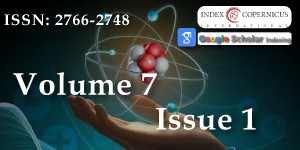Deriving the Average Change in Kinetic Energy of a Galaxy in Non-Relativistic Motion
Main Article Content
Abstract
This study presents a novel approach to calculating the average change in kinetic energy of galaxies exhibiting non-relativistic motion. The methodology integrates the dynamics of total observed motion, which encompasses both peculiar and recessive motion, with the gravitational influence of neighboring galaxies. The peculiar motion is quantified through peculiar redshift, while recessive motion is described by Hubble’s Law. The total observed velocity is the sum of these two components. The research derives an expression for the average acceleration of a galaxy based on the change in its total observed redshift wavelength over time. Utilizing Newton’s Second Law of Motion, the average observed force and subsequent work done by this force is calculated. The work done by conservative forces, primarily gravitational forces exerted by neighboring galaxies, is also considered to determine the total work done on the galaxy. Results indicate that the average total observed force causing the motion of a galaxy is a non-conservative force, resulting from the combined effects of non-conservative forces responsible for peculiar and recessive motion. The change in potential energy due to gravitational interactions with neighboring galaxies is accounted for, leading to the formulation of the average change in kinetic energy. The conclusion of the paper provides a comprehensive expression for the average change in kinetic energy of a galaxy, factoring in the mass of the galaxy, the speed of light, the total observed redshift, the change in distance with respect to Earth, and the gravitational constant. This expression is significant for understanding the dynamics of galactic motion and the forces at play in a non-relativistic context.
Article Details
Copyright (c) 2024 Sharma D.

This work is licensed under a Creative Commons Attribution 4.0 International License.
The International Journal of Physics Research and Applications is committed in making it easier for people to share and build upon the work of others while maintaining consistency with the rules of copyright. In order to use the Open Access paradigm to the maximum extent in true terms as free of charge online access along with usage right, we grant usage rights through the use of specific Creative Commons license.
License: Copyright © 2017 - 2025 |  Open Access by International Journal of Physics Research and Applications is licensed under a Creative Commons Attribution 4.0 International License. Based on a work at Heighten Science Publications Inc.
Open Access by International Journal of Physics Research and Applications is licensed under a Creative Commons Attribution 4.0 International License. Based on a work at Heighten Science Publications Inc.
With this license, the authors are allowed that after publishing with the journal, they can share their research by posting a free draft copy of their article to any repository or website.
Compliance 'CC BY' license helps in:
| Permission to read and download | ✓ |
| Permission to display in a repository | ✓ |
| Permission to translate | ✓ |
| Commercial uses of manuscript | ✓ |
'CC' stands for Creative Commons license. 'BY' symbolizes that users have provided attribution to the creator that the published manuscripts can be used or shared. This license allows for redistribution, commercial and non-commercial, as long as it is passed along unchanged and in whole, with credit to the author.
Please take in notification that Creative Commons user licenses are non-revocable. We recommend authors to check if their funding body requires a specific license.
Tamara MD, Morag IS. Deriving accurate peculiar velocities (even at high redshift), MNRAS. 2014; 442.
Ianuzzi. On the orbital and internal evolution of cluster galaxies, MNRAS. 2012; 427.
Paulino-Afonso. Nature and nurture in galaxy structure and morphology, Astron. Astrophys. 2019; 630.
Leconte-Chevillard. Eddington, Milne and the cosmological debates of the 1930s, 2020.
Rebhan. Cosmic inflation and big bang interpreted as explosions. PhysRevD. 2012.

